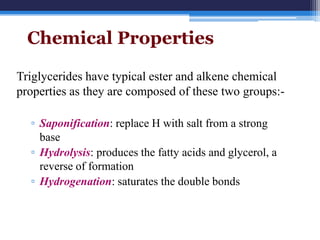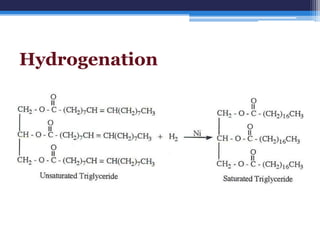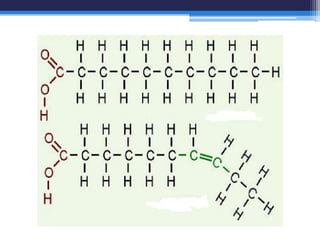Fatty acids and triglycerides
- 1. CHM4201:SPECIAL TOPIC IN ORGANIC CHEMISTRY Triglycerides and Chemistry of Fatty acids Group Members: Nur Fatihah binti Abas (154120) Faridah binti Sulaiman (154603) Wan Fatihah Nasuha binti Wan Nor (154115) Lecturer’s Name: Prof. Mawardi Rahmadi
- 2. Learning outcomes: 1) To understand about fatty acid and triglycerides. 2) To know the physical and chemical properties of fatty acid and triglycerides. 3) To distinguish between fatty acid and triglycerides.
- 3. Fatty Acids • Long straight-chain carboxylic acids ▫ no branching • Most common chains range from 10–20 carbons in length • Usually, an even number of carbons in the chain, including the carboxyl carbon • Can be saturated or unsaturated, but usually no other functional groups present ▫ Any fatty acid that cannot be synthesized by the body is called an essential fatty acid
- 4. Structure of fatty acids • A fatty acid is nothing more than a long C-H chain with a carboxyl group (COOH) on the end. • The COOH gives it an acid property. • The 3….dots represent the chain is very long.
- 5. Physical Properties of Fatty Acids • Solubility >Longer chains • more hydrophobic, less soluble. >Double bonds increase solubility. • Melting points • Depend on chain length and saturation • Double bonds lead chain disorder and low melting temperature. • Unsaturated FAs are solids at Room Temperature.
- 6. Fatty Acids • The most common fatty acids. Carbon Atoms: Common Melting Point Double Bonds Name (°C) Satur ated Fatty Acids 12:0 Lauric acid 44 Higher mp 14:0 Myristic acid 58 16:0 Palmitic acid 63 18:0 Ste aric acid 70 20:0 Arachidic acid 77 Uns aturated Fatty Acids Lower mp 16:1 Palmitoleic acid 1 18:1 Oleic acid 16 18:2 Linole ic acid -5 18:3 Linole nic acid -11 20:4 Arachidonic acid -49
- 7. Types of fatty acids The Length of • long-chain the Carbon • medium-chain Chain • short-chain The Degree of • saturated Unsaturation • unsaturated The Location of • omega-3 fatty acid Double Bonds • omega-6 fatty acid
- 8. The Length of the Carbon Chain Short-chain Fatty Acid (less than 6 carbons) Medium-chain Fatty Acid (6-10 carbons) Long-chain Fatty Acid (12 or more carbons)
- 10. Saturated The Degree of Unsaturation Monounsaturated Unsaturated (cis or trans configuration) Polyunsaturated
- 11. Saturated and Unsaturated FAs • Saturated FAs have no double bonds. (C-C) Double bonds lower the melting temperature • Unsaturated FAs have at least one double bond (C=C) in one of the fatty acids
- 12. Saturated Fatty Acid All single bonds between carbons
- 13. Monounsaturated Fatty Acid One carbon-carbon double bond
- 14. Polyunsaturated Fatty Acid More than one carbon-carbon double bond
- 15. Structure • Stearic acid: a typical saturated fatty acid with 18 carbons in the chain • Oleic acid: a typical unsaturated fatty acid with 18 carbons in the chain
- 16. Cis-fatty acid: H’s on same side of the double bond; fold into U-like formation; naturally occurring. Trans-fatty acid: H’s on opposite side of double bond; more linear; occur in partially hydrogenated foods
- 19. Location of Double Bonds • Polyunsaturated fatty acid (PUFA) are identified by position of the double bond nearest the methyl end (CH3) of the carbon chain; this is described as a omega number. • If PUFA has first double bond 3 carbons away from the methyl end => omega 3 FA • 6 carbons from methyl end => omega 6 FA
- 20. Omega-3 Omega-6
- 21. Fatty Acid Nomenclature • Nomenclature reflects location of double bonds • Also used are common names (e.g: oleic, stearic, palmitic) • Linoleic is also known as 18:2 n-6 • This means the FA is 18 carbons in length, has 2 double bonds, the first of which is on the 6th carbon • Arachidonic => 20:4 n-6
- 22. Classification and Structure-Saturated Fatty Acids Common Name Systematic Name Formula O Butyric acid n-butanoic CH3(CH2)2C OH O Caproic acid n-hexanoic CH3(CH2)4C OH O Caprylic acid n-octanoic CH3(CH2)6C OH O Capric acid n-decanoic CH3(CH2)8C OH O Lauric acid n-dodecanoic CH3(CH2)10C OH
- 23. Common Name Systematic Name Formula O Myristic acid n-tetradecanoic CH3(CH2)12C OH O Palmitic acid n-hexadecanoic CH3(CH2)14C OH O Stearic acid n-octadecanoic CH3(CH2)16C OH O Arachidic acid n-eicosanoic CH3(CH2)18C OH O Behenic acid n-docosanoic CH3(CH2)20C OH O Lignoceric acid n-tetracosanoic CH3(CH2)22C OH
- 24. Naming for Unsaturated FAs 10 9 8 7 6 5 4 3 2 1 O 1 9 C H3(C H2)7 HC CH C H2 CH2 CH2 CH2 C H2 CH2 C H2 C OH Δ 9, 10 - Octadecenoic acid 9 - Octadecenoic acid
- 25. Common Name of Fatty Acids Common Name Systematic Name Myristoleic 9-tetradecenoic acid Palmitoleic 9-hexadecenoic acid Oleic 9-octadecenoic acid Vaccenic 11-octadecenoic acid Erucic 13-docosenoic acid
- 26. Chemical Reactions of Fatty Acids Esterification reacts fatty acids with alcohols to form esters and water
- 27. Fatty Acid Hydrolysis • Acid Hydrolysis reverses esterification ▫ Fatty acids are produced from esters
- 28. Saponification • Saponification is the base-catalyzed hydrolysis of an ester • Products of the reaction are ▫ An alcohol ▫ An ionized salt which is a soap Soaps have a long uncharged hydrocarbon tail Also have a negatively charged carboxylate group at end Form micelles that dissolve oil and dirt particles
- 29. Reaction at the Double Bond • Hydrogenation is an addition reaction • Unsaturated fatty acids can be converted to saturated fatty acids • Hydrogenation is used in the food industry O CH3 CH2 4CH CH CH2CH CH CH2 7 C OH 2 H2, Ni O CH3 CH2 16 C OH
- 30. Hydrogenation
- 31. Triglycerides • An ester of glycerol with three fatty acids. • Also known as triacylglycerols • One type of lipid categorised as simple lipid.
- 32. Structure of Triglycerides • Glycerides are lipid esters • A triglyceride places fatty acid chains at each alcohol group of the glycerol O CH2O C R1 Glycerol O part CH O C R2 Fatty acid O chains CH2O C R3
- 33. Glycerol • Glycerol Always looks the same • 3 C’s with 3 OH’s and everything else H’s.
- 36. Example of triglycerides ▫ Triglyceride derived from one molecule each of palmitic acid, oleic acid, and stearic acid, the three most abundant fatty acids in the biological world. O p almitate (16:0) oleate (18:1) O CH2 OC(CH2 ) 1 4 CH3 stearate (18:0) CH3 ( CH2 ) 7 CH=CH(CH2 ) 7 COCH O CH2 OC(CH2 ) 1 6 CH3
- 37. Physical properties of triglycerides • Physical properties depend on the fatty acid components. ▫ Melting point increases as the number of carbons in its hydrocarbon chains increases and as the number of double bonds decreases. ▫ Oils: Triglycerides rich in unsaturated fatty acids are generally liquid at room. ▫ Fats: Triglycerides rich in saturated fatty acids are generally semisolids or solids at room temperature.
- 38. Physical properties of triglycerides ▫ Hydrocarbon chains of saturated fatty acids can lie parallel with strong dispersion forces between their chains; they pack into well-ordered, compact crystalline forms and melt above room temperature. ▫ Because of the cis configuration of the double bonds in unsaturated fatty acids, their hydrocarbon chains have a less ordered structure and dispersion forces between them are weaker; these triglycerides have melting points below room temperature.
- 39. Chemical Properties Triglycerides have typical ester and alkene chemical properties as they are composed of these two groups:- ▫ Saponification: replace H with salt from a strong base ▫ Hydrolysis: produces the fatty acids and glycerol, a reverse of formation ▫ Hydrogenation: saturates the double bonds
- 40. Triglyceride Reactions • Triglycerides undergo three basic reactions • These reactions are identical to those studied in carboxylic acids Triglyceride H2O, H+ H2, Ni NaOH Glycerol Fatty Acids More saturated Glycerol triglyceride Fatty Acid Salts
- 41. Hydrolysis
- 42. Saponification
- 43. Hydrogenation
- 47. What’s What? • Identify the glycerol molecule • The fatty acids
















































